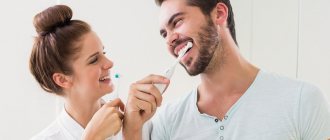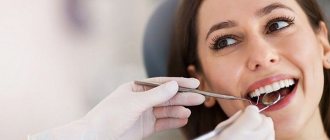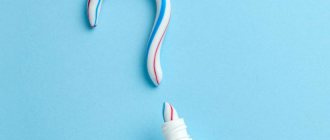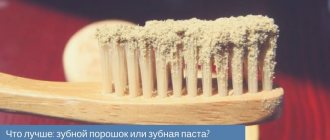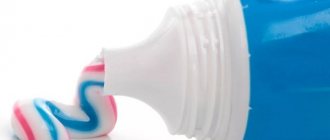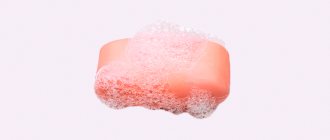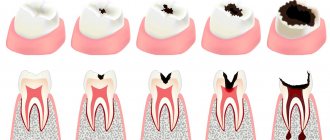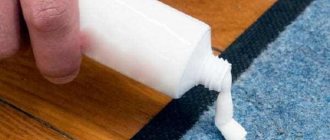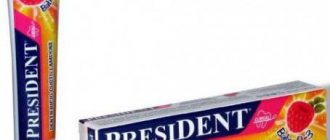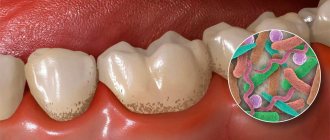The trend for organics and natural beauty products and tools is not slowing down, and even, on the contrary, is coming to those areas where, it would seem, there is only room for a professional approach. We're talking about dentistry. Several thousand years ago, there was a product that replaced people’s toothbrush, toothpaste, and even irrigator. It's about miswak. And now they are talking about him again. Outwardly, a miswak is a stick, the tip of which, after chewing, becomes like a brush; it is a kind of analogue of a brush for cleaning teeth. They are made from arak wood, better known as salvadora persica. They were traditionally used in the Middle East, but over time have become popular in Asia, and more recently in Europe, America and Canada.
Owner of the clinic Dr. SHIPKOV dental clinic Vladimir Shipkov explains if this trend has a future.
Alternative to a toothbrush
In a situation where you don’t have a brush at hand, you should use natural material. We are talking about a branch of a coniferous tree, be it pine, spruce or fir. It is enough to tear off a small stalk and place it in hot water. The tip of this product is softened by lightly chewing with your teeth. The end result is something like a brush. The product is carefully passed over the surface of the teeth, removing accumulated plaque.
Separately chew pine needles, which are rich in vitamin C, vegetable oils, and amino acids. In combination, the noted substances have a disinfecting and anti-inflammatory effect on the tissues of the oral cavity. Chewing pine needles for several minutes strengthens tooth enamel and gums.
Using a softened pine twig, it is important to thoroughly clean not only the internal, but also the external surfaces of the enamel. Particular attention should be paid to the bases of the molars. After all, it is here that the salivary ducts are located and the formation of tartar is most often observed.
How to brush your teeth with an electronic brush?
As with a manual toothbrush, you should hold it at a 45° angle. But the steps are much simpler: you just need to move from tooth to tooth
. First - along the front surfaces, then - along the back and chewing surfaces, and finally - brush along the gum line and clean your tongue. You need to move the brush slowly: each tooth should have a few seconds of brushing. In total, the procedure takes the same amount of time as a manual one: two minutes. Your electric toothbrush may even have a timer set for this time.
Soda
How to brush your teeth if you don't have toothpaste? A good option is using baking soda. The substance has a non-toxic composition. The powder has an abrasive structure, which promotes high-quality plaque removal. The product has disinfecting properties. In addition to removing bacterial waste products, baking soda is a good teeth whitener.
To brush your teeth without toothpaste, dip a toothbrush or a piece of sterile cotton wool in baking soda. The substance is treated with chewing surfaces. To enhance the positive effect, you can add a couple of drops of lemon juice to the powder. At the end of the procedure, the oral cavity is thoroughly rinsed with water.
After brushing your teeth with baking soda, it is important to avoid eating food and hot drinks for an hour. The abrasive can leave microscopic damage on the enamel. Various types of influences can provoke cracking of the tooth surface in the future.
Doctors do not recommend regularly brushing and whitening your teeth with baking soda. The reason is the same scratching of the enamel by powder crystals. Particles of the substance remaining in the oral cavity can provoke inflammation of the gums and mucous membranes.
How to replace toothpaste at home
Traditional (homemade) toothpaste substitutes include many substances and compositions. It is worth considering that it is not advisable to consider them as a long-term alternative, since their action is rather narrowly focused and in some cases their effectiveness does not have high indicators.
Activated carbon
Can be used both in pure form and with the addition of hydrogen peroxide. The latter has an antimicrobial effect, while the charcoal itself cleans and whitens tooth enamel. For one use, 1 tablet and 1-2 drops of peroxide are enough. Activated carbon does not require grinding, because upon contact with liquid it takes on a mushy state.
Charcoal has a good whitening effect. It should be noted that charcoal is a fairly active abrasive and, with prolonged use, can have a traumatic effect on tooth enamel.
Powder for teeth
You can prepare tooth powder at home by mixing: bentonite clay (30g), soda (30g), xylitol (15g), sea salt (7.5g), mint oil (5 drops), dried sage leaves (15g). The mixture is mixed with a wooden spatula and stored in a tightly closed container. This powder is a good replacement for toothpaste at home and in other conditions and is an almost exact analogue of the powder produced under industrial conditions. However, it is worth considering that any powder is an abrasive agent and requires short-term use to avoid damage to the enamel.
Salt
You can use either regular table salt or sea salt. Salt has a good anti-inflammatory effect, but it must be used carefully, mixed with water until it becomes pasty. Otherwise, hard particles with sharp edges can lead to microdamage to the enamel and cause increased tooth sensitivity.
Soda
It is another abrasive agent in the question of “ what to replace toothpaste with .” To create a cleaning mass, 1/2 teaspoon of baking soda must be mixed with 1/4 part of water. This mixture freshens breath and fights well against plaque on teeth, preventing the formation of tartar. To achieve a whitening effect, you can add 1-2 drops of lemon juice to the soda. Please note that after cleaning with soda, it is advisable to avoid drinking hot and cold drinks and food for 1-2 hours to prevent cracking of the enamel.
Herbal preparations
Mint, cloves, sage, thyme, anise and calamus root can be used as constituent units. Crushed roots of calamus can be mixed with an aqueous solution of propolis in almost arbitrary proportions.
The use of such mixtures has a beneficial effect on the gums and mucous membranes of the oral cavity. This type of hygiene products should be used with caution, taking into account the possibility of individual intolerance and the risk of developing allergic reactions.
Tea tree oil
Tea tree-based compositions have a good antibacterial and aromatizing effect. The composition is prepared by adding tea tree oil to warm water at the rate of 3-4 drops per glass of water. Such treatment has a particularly beneficial effect on the gums of people prone to developing periodontal disease and caries.
Banana peel
Few people know that banana peel has a good cleansing agent and whitening effect.
Powdered milk
Has a beneficial effect on the gums of people prone to bleeding. Produces gentle cleaning while neutralizing unpleasant odors.
Ash
You cannot use ash from resinous wood or recycled plywood. As a replacement for toothpaste, willow, birch, linden and oak are best suited for these purposes. Ash has a good bleaching effect and can serve as a good alternative to activated carbon due to its fineness, which allows for gentle cleaning.
White clay
It can be used both as an independent product and as part of a homemade combined tooth powder.
Laundry soap
Soap is a good antibacterial and antimicrobial agent. The main disadvantage of this method of cleaning teeth is the unpleasant taste in the mouth.
Lagerstroemia (Indian lilac)
A plant component with powerful antibacterial and anti-inflammatory effects. Provides a good therapeutic effect in the treatment and prevention of gingivitis, caries and some other diseases of the oral cavity.
Oils
Coconut oil and tea tree oil are popular alternatives to toothpaste. Most are used as rinsing solutions and as a component of herbal mixtures.
Tea tree oil
People who want to know how to brush their teeth if they don’t have toothpaste should use tea tree oil. The product contains a lot of biologically active elements that inhibit the activity of pathogenic bacteria that parasitize tooth enamel. The product has a pleasant aroma, eliminating bad odors.
The hygiene procedure is carried out according to the following scheme:
- prepare a glass of warm boiled water;
- add about 3-4 drops of tea tree oil to the liquid;
- the composition moisturizes the toothbrush and removes plaque from the enamel;
- Finally, rinse the mouth with the product several times.
It is useful to perform the procedure daily, before going to bed. Regular use of tea tree oil for oral care reduces the likelihood of developing inflammatory processes in the structure of gum tissue. The folk remedy is suitable for combating caries and periodontal disease.
Should you brush your teeth before or after breakfast?
Better after: then the less food debris, bacteria and saliva on the enamel, the lower the risk of developing oral diseases. But you shouldn’t brush your teeth immediately after breakfast (or any other meal). First you need to rinse your mouth with water, wait an hour (or at least 30 minutes) - and only then start cleaning. Especially if you drank coffee or ate grapefruit: acidic food makes the enamel more vulnerable, and cleaning can harm it. If you don’t have time to take a long break between breakfast and oral hygiene (you need to run to work, for example), brush your teeth before breakfast.
Wood ash
What can you use to brush your teeth instead of toothpaste? An ancient folk method is the use of ash. In nature, cooled coals should be taken from the fire. The substance is ground into powder. Add a couple of drops of water until a thick, paste-like consistency is formed. The product is applied to the finger and passed over the surfaces of the teeth. Finally, rinse your mouth with plenty of water. As a result, the enamel gets rid of accumulated plaque and becomes clean and snow-white.
Wood ash is more than just an abrasive. The product contains potassium, calcium, phosphorus, manganese, iron. The complex of these elements creates a special environment in the oral cavity that is not suitable for the active reproduction of pathogenic microorganisms. If you add ground mint leaves to a paste prepared from ash, you can get a product with a pleasant taste and aroma.
What can you replace toothpaste with: conclusion
Having considered all of the above methods for replacing toothpaste, we can come to the conclusion that it is advisable to combine most of them, and some (salt, soda, charcoal, etc.) are not suitable for long-term use due to their powerful abrasive properties. One of the most effective and safe alternatives can be considered an irrigator and herbal mixtures.
In the question “ what to replace toothpaste with ,” all the methods indicated can be suitable, subject to the rules of use and the absence of abuse. We also recommend that you read our article: how often should you change your toothbrush, as well as the article on how to brush your teeth correctly:.
Clay
What to do if you don't have toothpaste? How to brush your teeth? A good idea would be to use white or blue clay powder. The product is absolutely harmless to the body. The substance contains an abundance of microelements that disinfect oral tissues. Brushing your teeth with clay helps eliminate bad odor.
To rid the enamel of plaque, freshen breath and achieve a whitening effect, I act according to the following principle:
- take about 50-70 grams of white or blue clay;
- the product is moistened with a few drops of water;
- the product is mixed until a mass of paste-like consistency is formed;
- add a dessert spoon of liquid honey, as well as a couple of drops of propolis infusion, essential oils of sage and chamomile.
The prepared paste is applied to a damp brush. Brush your teeth, carefully treating the enamel surfaces. Finally, rinse your mouth with water. Performing the procedure in the morning and evening has the most positive effect on oral health.
How it works?
For hygienic needs, the roots and branches of Salvadora Persian are used. The first ones are tougher, but contain more nutrients. The latter have a more delicate texture, so they are more suitable for people with sensitive enamel and gum disease. Both are cut into sticks 15-20 centimeters long, and then the tip (1-2 centimeters) is cleared of the bark. Then it is turned into a brush by simply chewing it. The fibrous structure of wood is ideal for mechanical teeth cleaning, and the set of useful substances in the fibers functions as both a toothpaste and a mouthwash.
In addition to sticks, tinctures and solutions are made from Salvadora Persian. Arak extracts are added to tooth powders, pastes and rinses. They are actively used in pharmacology, in particular to suppress the growth of pathogenic bacteria in candidiasis. The high concentration of tannins in wood eliminates inflammation and stops bleeding of mucous membranes, fluoride suppresses pathogenic microflora, calcium protects teeth from destruction, and silicon oxide has a mild whitening effect.
Healing herbs
When looking for effective folk remedies for cleaning teeth, you should pay attention to plants such as mint, sage, calamus root, thyme, and cloves. These herbs are combined in equal proportions and ground to a powdery consistency. The resulting product is applied to a moistened brush. Perform delicate teeth cleaning. Using the method allows you to remove plaque, disinfect the oral cavity and improve the condition of the gums.
Myth 3. All family members can use the same toothpaste
Often the name of the paste emphasizes its versatility. But this, according to the professor of dentistry, is just a thoughtful move by the manufacturer. There are no funds that would be suitable for an adult, a child, or a pensioner. “Common” in toothpaste is acceptable if all family members are of working age and they have the same oral problem, for example, bleeding gums or pigmented plaque on the teeth.
Children should buy pasta strictly according to age - 3+, 7+, 16+. This is primarily due to different concentrations of fluorides, which are beneficial for teeth, but can be toxic in excess. Compared to “adult” toothpaste, the fluoride content in toothpaste for preschoolers should be 3 times less (up to 500 ppm). A self-respecting manufacturer indicates these values on the box or tube of paste in the “composition” section. If there is no such information, there is reason to doubt the quality of the product.
A child who regularly uses “adult” toothpaste can become poisoned, especially if accidentally swallowed. In addition, pastes intended for adults contain abrasives and antiseptics, which are also harmful to children.
Kitchen salt
The mineral substance is known for its disinfecting properties. Thanks to its crystalline structure, the product perfectly cleanses plaque from tooth enamel. The effect of salt on the gums reduces the likelihood of developing inflammatory and putrefactive processes. The oral cavity gets rid of unpleasant odor.
You can use sea salt to clean your teeth. The product is a source of a wide range of microelements: iodine, manganese, phosphorus, calcium, silicon, iron. The noted elements have an antiseptic effect on the tissues of the oral cavity.
How to brush your teeth without toothpaste? The salt is thoroughly ground in a mortar until it becomes dusty. Add a couple of drops of vegetable oil. A damp brush is dipped in the substance. Next, teeth are brushed according to the usual principle. Finally, the oral cavity is thoroughly rinsed with water.
Myth 2. For good hygiene you need a lot of toothpaste
If you are a generous soul and squeeze the paste out the entire length of the brush, as it is positioned in commercials, the manufacturer will be very happy - you will run out of paste faster and you will go buy a new tube. However, according to Professor Terekhova, in order for toothpaste to fulfill its therapeutic and preventive purpose, very little of it is needed. Hold the tube with the opening facing up, press lightly to release a little paste, and use a brush moistened with water to pass over it once. Whatever lingers on the stubble is enough.
Moreover, an excess of foaming agents and other toothpaste additives can provoke a gag reflex in sensitive people and children, as well as other uncomfortable sensations that can lead to the development of an aversion to brushing teeth.
Myth 7. A brush with stiff bristles is the most effective.
Tamara Terekhova recommends buying toothbrushes with soft or medium hardness. Hard ones can only be used by patients with increased formation of pigmented plaque, who also have excellent enamel stability, strong gums, and single fillings. For others, it will injure the oral mucosa and contribute to the abrasion of enamel.
If you have problems cleaning interdental spaces and hard-to-reach places, preference should be given to brushes with milled tips. They easily penetrate into all areas of the tooth and do not injure the gums.
Organic Lebon pastes
The Lebon brand is a love story between the art and science of natural cosmetics. Its founders are a married couple: art critic and professional photographer Stephanie and her pharmacist and dermatologist husband Richard. Lebon toothpastes contain organic green tea and aloe vera, which prevent the growth of bacteria and plaque, protecting teeth and gums. A separate line of Whitening whitening pastes contains papaya extract - it gently removes plaque without causing damage to the enamel. The brand is based in France, and their products smell as if the aromatic compositions were collected in the perfume laboratories of Grasse - there are aromas of yuzu and ylang-ylang, orange blossom and mint, rooibos tea and pineapple.
